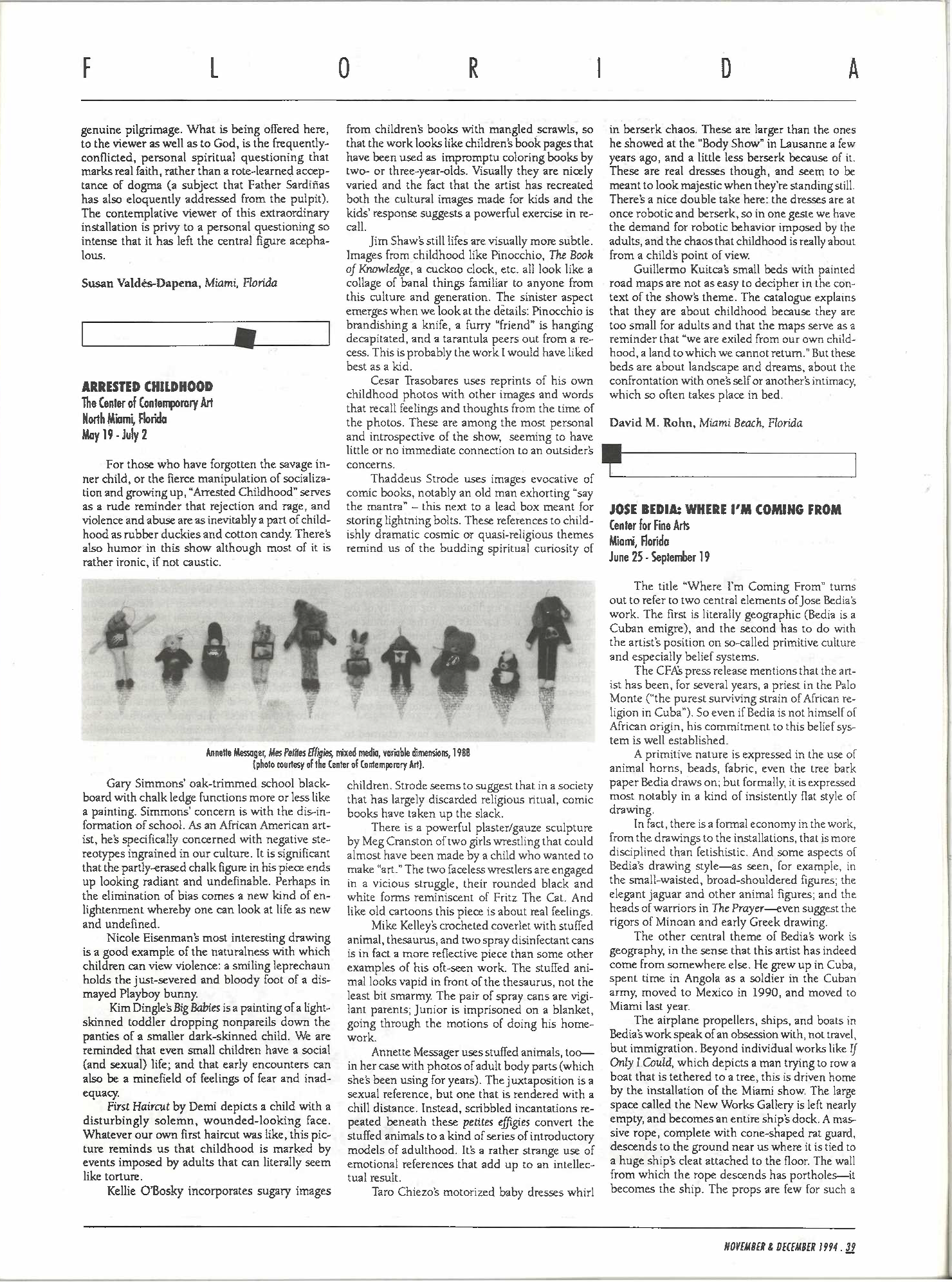Arrested Childhood
Share:
For those who have forgotten the savage inner child, or the fierce manipulation of socialization and growing up, “Arrested Childhood” serves as a rude reminder that rejection and rage, and violence and abuse are as inevitably a part of childhood as rubber duckies and cotton candy. There’s also humor in this show although most of it is rather ironic, if not caustic.
Gary Simmons’ oak-trimmed school blackboard with chalk ledge functions more or less like a painting. Simmons’ concern is with the dis-information of school. As an African American artist, he’s specifically concerned with negative stereotypes ingrained in our culture. It is significant that the partly-erased chalk figure in his piece ends up looking radiant and undefinable. Perhaps in the elimination of bias comes a new kind of enlightenment whereby one can look at life as new and undefined.
Nicole Eisenman’s most interesting drawing is a good example of the naturalness with which children can view violence: a smiling leprechaun holds the just-severed and bloody foot of a dismayed Playboy bunny.
Kim Dingle’s Big Babies is a painting of a light-skinned toddler dropping nonpareils down the panties of a smaller dark-skinned child. We are reminded that even small children have a social (and sexual) life; and that early encounters can also be a minefield of feelings of fear and inadequacy.
First Haircut by Demi depicts a child with a disturbingly solemn, wounded-looking face. Whatever our own first haircut was like, this picture reminds us that childhood is marked by events imposed by adults that can literally seem like torture.
Kellie O’Bosky incorporates sugary images from children’s books with mangled scrawls, so that the work looks like children’s book pages that have been used as impromptu coloring books by two- or three-year-olds. Visually they are nicely varied and the fact that the artist has recreated both the cultural images made for kids and the kids’ response suggests a powerful exercise in recall.
Jim Shaw’s still lifes are visually more subtle. Images from childhood like Pinocchio, The Book of Knowledge, a cuckoo clock, etc. all look like a collage of banal things familiar to anyone from this culture and generation. The sinister aspect emerges when we look at the details: Pinocchio is brandishing a knife, a furry “friend” is hanging decapitated, and a tarantula peers out from a recess. This is probably the work I would have liked best as a kid.
Cesar Trasobares uses reprints of his own childhood photos with other images and words that recall feelings and thoughts from the time of the photos. These are among the most personal and introspective of the show, seeming to have little or no immediate connection to an outsider’s concerns.
Thaddeus Strode uses images evocative of comic books, notably an old man exhorting “say the mantra” – this next to a lead box meant for storing lightning bolts. These references to childishly dramatic cosmic or quasi-religious themes remind us of the budding spiritual curiosity of children. Strode seems to suggest that in a society that has largely discarded religious ritual, comic books have taken up the slack.
There is a powerful plaster/gauze sculpture by Meg Cranston of two girls wrestling that could almost have been made by a child who wanted to make “art”. The two faceless wrestlers are engaged in a vicious struggle, their rounded black and white forms reminiscent of Fritz The Cat. And like old cartoons this piece is about real feelings.
Mike Kelley’s crocheted coverlet with stuffed animal, thesaurus, and two spray disinfectant cans is in fact a more reflective piece than some other examples of his oft-seen work. The stuffed animal looks vapid in front of the thesaurus, not the least bit smarmy. The pair of spray cans are vigilant parents; Junior is imprisoned on a blanket, going through the motions of doing his homework.
Annette Messager uses stuffed animals, too – in her case with photos of adult body parts (which she’s been using for years). The juxtaposition is a sexual reference, but one that is rendered with a chill distance. Instead, scribbled incantations repeated beneath these petites effigies convert the stuffed animals to a kind of series of introductory models of adulthood. It’s a rather strange use of emotional references that add up to an intellectual result.
Taro Chiezo’s motorized baby dresses whirl in berserk chaos. These are larger than the ones he showed at the “Body Show” in Lausanne a few years ago, and a little less berserk because of it. These are real dresses though, and seem to be meant to look majestic when they’re standing still. There’s a nice double take here: the dresses are at once robotic and berserk, so in one geste we have the demand for robotic behavior imposed by the adults, and the chaos that childhood is really about from a child’s point of view.
Guillermo Kuitca’s small beds with painted road maps are not as easy to decipher in the context of the show’s theme. The catalogue explains that they are about childhood because they are too small for adults and that the maps serve as a reminder that “we are exiled from our own childhood, a land to which we cannot return.” But these beds are about landscape and dreams, about the confrontation with one’s self or another’s intimacy, which so often takes place in bed.
